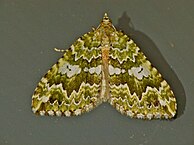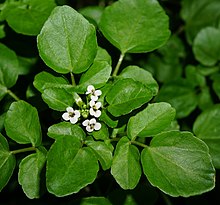Asaphodes beata
| Asaphodes beata | |
|---|---|

| |
| Female | |

| |
| Male | |
| Scientific classification | |
| Domain: | Eukaryota |
| Kingdom: | Animalia |
| Phylum: | Arthropoda |
| Class: | Insecta |
| Order: | Lepidoptera |
| Family: | Geometridae |
| Genus: | Asaphodes |
| Species: | A. beata
|
| Binomial name | |
| Asaphodes beata | |
| Synonyms[1] | |
| |
Asaphodes beata (also known as the dotted green carpet moth)[2] is a species of moth in the family Geometridae.[3] It is endemic to New Zealand and is a relatively common species that can be found throughout the country in native forest or scrub habitat. It can be distinguished from its close relative Asaphodes adonis by the colour of its hind wings. The larvae of this species feeds on watercress but tends to be inactive during the day. If threatened it will mimic a twig dropping to the ground. The adult moths are on the wing from October to March and are said to be attracted to white rātā. The white markings on the forewing of the adults are variable in appearance.
Taxonomy
[edit]This species was first described by Arthur Gardiner Butler in 1877 as Cidaria beata using a specimen from the collection of J. D. Enys.[4] In 1884 Edward Meyrick placed this species in the genus Larentia.[5] George Hudson discussed and illustrated this species both in his 1898 book under the name Xanthorhoe beata and again in his 1928 publication under the name Xanthorhoe benedicata.[6][7] In 1927 Louis Beethoven Prout synonymised Xanthorhoe benedicta with Xanthorhoe beata.[8] In 1939 Prout placed this species back in the genus Larentia.[9] However this placement was not accepted by New Zealand taxonomists.[10] In 1971 J. S. Dugdale placed this species in the genus Asaphodes.[11] This placement was affirmed by Dugdale in 1988.[12] The male holotype specimen, likely collected at Castle Hill in mid Canterbury, is held at the Natural History Museum, London.[12]
Description
[edit]

Hudson described the egg of this moth as being:
about one fiftieth of an inch in length, oval, considerably flattened, with a distinct concavity on each side. It is green, highly polished, with numerous very shallow hexagonal depressions. Its colour changes to greyish-green about two days prior to hatching.[7]
He described the larvae as:
orange-brown, becoming greenish-brown soon after emergence. The full-grown larva is dark brown above and pale brown beneath, the two colours being sharply separated on the sides by a broken white line. A series of V-shaped markings is situated on the back, each mark enclosing a paler area. Several fine black wavy lines traverse the darker portions of the larva, and a dark mark, edged with black beneath, is situated on each segment just above the ventral surface.[6]
The larva forms a frail cocoon on the ground in which it pupates.[6]
Butler originally described the adults of this species as follows:
Above very similar in pattern to the preceding species, but much smaller, and the primaries with all the markings olive-green instead of bronzy brown ; the secondaries white instead of yellow, with a pale pinky brown outer border ; thorax olive-green ; abdomen testaceous : primaries below with the basal area, to the extremity of the dentated central band of the upper surface, madder-brown ; costa testaceous, tinted with olivaceous, and crossed by ferruginous bars ; disk whity-brown ; apex and outer border shining testaceous, almost golden ; a submarginal series of white dots ; fringe silvery white, black-spotted ; secondaries pale testaceous, increasing in intensity to the outer border, which is golden, crossed by parallel crenate olivaceous lines, three of which form a central band, relieved externally by white lunules ; disk crossed by paler olivaceous lines, followed by a submarginal series of white lunules ; body below testaceous. Expanse of wings 1 inch.[4]
This species can be distinguished from its close relative A. adonis by the colour of its hind wings.[13] Hudson states that the white markings on the forewings of this moth are variable.[6] This species is very similar in appearance to A. philpotti, to the point where A. philpotti was previously encapsulated within the concept of this species.[14]
Distribution
[edit]This species is endemic to New Zealand.[1] This relatively common species can be found in forest throughout the country.[2]
Behaviour
[edit]The larvae of this species is inactive during the day and when threatened mimics a twig dropping to the ground.[7] Adult moths are on the wing from October until March.[7]
Habitat
[edit]This species inhabits native forest and scrub.[7]
Host species
[edit]
Hudson stated that the larvae of this species feed on watercress.[6] Larvae have also been found on native herb plants in the genera Epilobium, Cardamine, and Stellaria.[15] Adults are said to be attracted to the flowers of the white rātā.[6]
References
[edit]- ^ a b c "NZOR Name Details - Asaphodes beata (Butler, 1877)". www.nzor.org.nz. Landcare Research New Zealand Ltd. Retrieved 15 February 2017.
- ^ a b Crowe, Andrew (2017). Which New Zealand insect?. Penguin Books. p. 20. ISBN 978-0-14-100636-9.
- ^ Gordon, Dennis P., ed. (2010). New Zealand inventory of biodiversity: Kingdom animalia: chaetognatha, ecdysozoa, ichnofossils. Vol. 2. p. 458. ISBN 978-1-877257-93-3. OCLC 973607714. OL 25288394M. Wikidata Q45922947.
- ^ a b Arthur G. Butler (1877). "On two Collections of Heterocerous Lepidoptera from New Zealand, with descriptions of new Genera and Species". Journal of Zoology. 1877: 397. ISSN 1469-7998. Wikidata Q109479517.
- ^ Edward Meyrick (May 1884). "A Monograph of the New Zealand Geometrina". Transactions and Proceedings of the New Zealand Institute. 16: 79–80. ISSN 1176-6158. Wikidata Q109615359.
- ^ a b c d e f George Vernon Hudson (1898), New Zealand moths and butterflies (Macro-lepidoptera), Illustrator: George Hudson, London, p. 63, doi:10.5962/BHL.TITLE.7912, OCLC 980865393, Wikidata Q19073637
{{citation}}: CS1 maint: location missing publisher (link) - ^ a b c d e George Vernon Hudson (1928), The butterflies and moths of New Zealand, Illustrator: George Hudson, Wellington: Ferguson and Osborn Limited, p. 117, LCCN 88133764, OCLC 25449322, Wikidata Q58593286
- ^ Louis Beethoven Prout (15 August 1927). "Notes on New Zealand Geometridae". Transactions and Proceedings of the New Zealand Institute. 58: 77. ISSN 1176-6158. Wikidata Q110670763.
- ^ Prout, L. B. (1939). "Geometridae: Fauna Indo-Australica". The Macrolepidoptera of the World. 12: 264 – via Biodiversity Heritage Library.
- ^ R. C. Craw (April 1987). "Revision of the genus Helastia sensu stricto with description of a new genus (Lepidoptera: Geometridae: Larentiinae)". New Zealand Journal of Zoology. 14 (2): 269–293. doi:10.1080/03014223.1987.10422997. ISSN 0301-4223. Wikidata Q54670161.
- ^ Dugdale, J. S. (10 November 1971). "Entomology of the Aucklands and other islands south of New Zealand: Lepidoptera, excluding non-crambine Pyralidae". Pacific Insects Monographs. 27: 55–172. ISSN 0078-7515. Wikidata Q64006453.
- ^ a b John Stewart Dugdale (23 September 1988). "Lepidoptera - annotated catalogue, and keys to family-group taxa". Fauna of New Zealand. 14. Department of Scientific and Industrial Research: 172. doi:10.7931/J2/FNZ.14. ISSN 0111-5383. Wikidata Q45083134.
- ^ Meyrick, E (1908). "Notes and descriptions of New Zealand lepidoptera". Transactions and Proceedings of the New Zealand Institute. 41: 6 – via Biodiversity Heritage Library.
- ^ Louis Beethoven Prout (15 August 1927). "Notes on New Zealand Geometridae". Transactions and Proceedings of the New Zealand Institute. 58: 77–78. ISSN 1176-6158. Wikidata Q110670763.
- ^ Brian H. Patrick (April 2000). Conservation status of two rare New Zealand geometrid moths (PDF). Vol. 145. pp. 1–21. ISBN 0-478-21946-6. ISSN 1173-2946. Wikidata Q109608608.
{{cite book}}:|journal=ignored (help)
